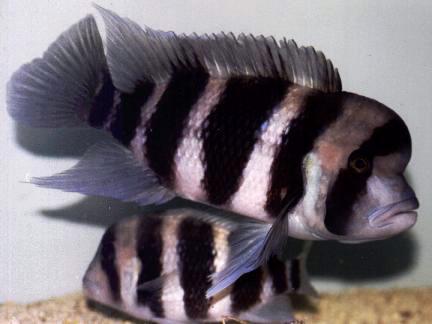 A pair of Cyphotilapia frontosa from the authors aquarium.
A pair of Cyphotilapia frontosa from the authors aquarium.
One of the most beautiful and distinctive Cichlids of Lake Tanganyika has to be C. frontosa. There are two colour morphs of this species, a Berundi morph, which has six vertical bars and a Tanzanian morph, which has seven or even eight bars when they are young, although in my experience I have only ever encountered the Berundi morph. The males develop a huge lump of fat on the top of its head making this a very distinctive occupant to any aquarium.
Before you go out with the idea of buying this species for your home aquarium it is important to be sure that the right living conditions can be provided. Lake Tanganyika has a very high pH of 9.5 and has double the dissolved salts found in Lake Malawi (Axelrod 1993). It is almost impossible to simulate these conditions in the home aquarium but an alkaline pH should be maintained by the addition of a coral gravel and Tuffa rock. Some keepers even add marine salt to the aquarium at 4.5g/litre.
The aquarium itself should be large as this species can grow as long as 14 inches in length and has a healthy appetite so adequate filtration is essential. These fish will accept most food types and a mixed diet of commercial pellet food and fresh foods such as beef heart or small snails with weak shells should be provided.
It is fair too say that this fish will only be seen in specialist pet shops and usually always commands a high price. To add to this if it is your aim to eventually breed this species you will have to purchase a number of individuals, I would recommend that at least six fish be purchased. This can work out expensive but is in practise the only solution as fully matured pairs are seldom seen and rarely for sale.
I began my personal experience with C. frontosa with six 1-2 inch individuals just over 2 years ago. The fish I had were relatively slow growing but growth was consistent. I was lucky to get three pairs from this batch and the biggest male is now about 7 inches long, the females are smaller at 4 inches. However, it has been my experience that these fish are very aggressive towards other members of the same species resulting in the males having to be separated into different aquariums. In order to prevent stress to the females I have placed all three females with the large male, which has proved successful.
Although C. frontosa is a large fish they are relatively shy and need quite extensive rockwork. The tank should also be fairly well stocked with other similar fish as this prevents your prize fish hiding. Suitable tank-mates should however be large but not too aggressive. I would recommend some of the more peaceful Malawi Cichlids, for example large Aulonocara species.
My frontosa's exhibit plenty of gravel moving and hole digging but as yet have not bred, this may however be because they are still maturing with the females still too small to breed at the present time. Keeping Cyphotilapia frontosa has proved to be a rewarding experience and trying to breed this species will provide a challenge to the experienced fish keeper.
Reference
Axelrod, H. R.; The Most Complete Coloured Lexicon of Cichlids; 2nd edition; 1993; T.F.H Publications, Inc.

